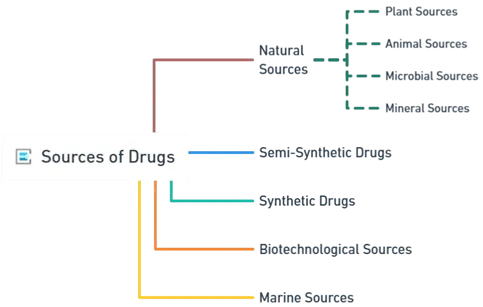Source of Drugs includes natural, synthetic, and biotechnological origins such as plants, animals, minerals, and microorganisms.
Drugs can be obtained from various natural, semi-synthetic, synthetic, and biotechnological sources.

1. Natural Source of Drugs
These are substances directly obtained from nature – plants, animals, microorganisms, or minerals.
-
-
Plant Sources
- Many traditional and modern medicines originate from plants.
- Parts used: leaves, bark, roots, seeds, flowers.
- Examples:
- Morphine – Opium poppy (Papaver somniferum)
- Atropine – Belladonna plant (Atropa belladonna)
- Quinine – Cinchona bark
- Digoxin – Foxglove plant (Digitalis purpurea)
-
Animal Sources
-
Microbial Sources
-
Mineral Sources
- Drugs derived from inorganic minerals.
- Examples:
- Magnesium sulfate – Used as a laxative and anticonvulsant.
- Iron – For treating anemia.
- Lithium – Mood stabilizer in bipolar disorder.
-
-
Semi-Synthetic Drugs
- These are natural substances that have been chemically modified to enhance properties such as efficacy, stability, or safety.
- Examples:
- Ampicillin – Modified from penicillin.
- Heroin – Derived from morphine.
- Hydrocortisone – From natural cortisol.
-
Synthetic Drugs
- Entirely man-made using chemical synthesis in laboratories.
- Allows precise control over drug structure and properties.
- Often cheaper and more stable than natural sources.
- Examples:
- Paracetamol (acetaminophen)
- Omeprazole
- Sulfonamides
- Benzodiazepines
-
Biotechnological Sources (Recombinant DNA Technology)
- Use of genetic engineering, cell cultures, or recombinant DNA to produce complex biologics.
- Allows for the production of human-identical proteins and hormones.
- Examples:
- Recombinant insulin (human insulin) – Produced by inserting human insulin gene into E. coli.
- Erythropoietin – Stimulates red blood cell production in anemia.
- Monoclonal antibodies – For autoimmune diseases and cancers.
-
Marine Source of Drugs
- A growing area of pharmacology, drugs are isolated from marine organisms like sponges, algae, and sea snails.
- Examples:
- Ziconotide – From cone snail venom (used for chronic pain).
- Trabectedin – From sea squirt, used in cancer treatment.
Click Here to Watch the Best Pharma Videos

